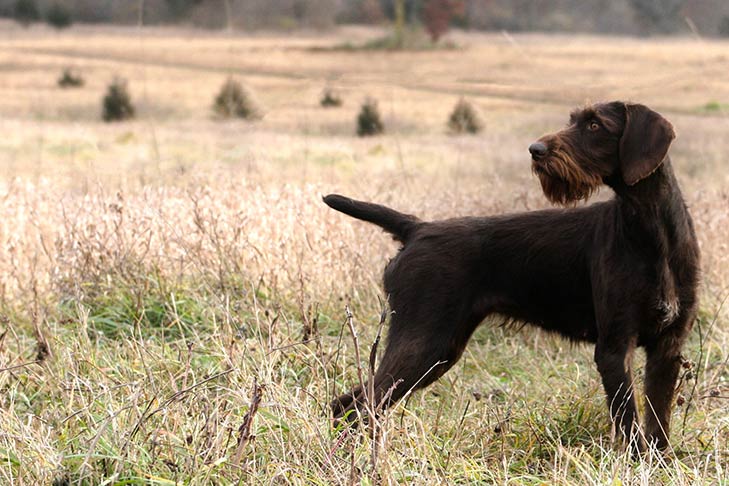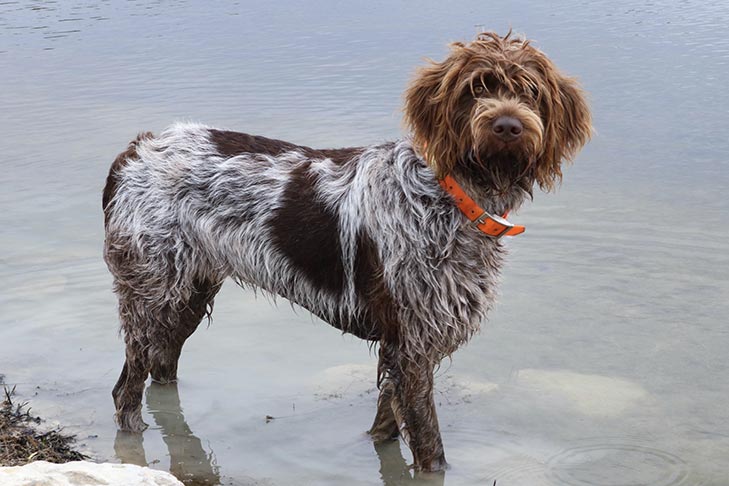- german shorthaired pointer
- german wirehaired pointer
- wirehaired pointing griffon
- pointer
- pointing breeds
The 14 Pointing breeds are among the most distinctive hunting members of the Sporting Group. Popular with people who enjoy running, hiking, and hunting, the Pointers excel at tracking upland game, and a few specialize in retrieving waterfowl.
Versatile, athletic, and courageous, Pointers are loyal companions in the field and at home. Some of these, like the Pointer, German Shorthaired Pointer, German Wirehaired Pointer, Wirehaired Pointing Griffon, Wirehaired Vizsla, and German Longhaired Pointer, are alike in many ways and unlike in only a few.
These include slight differences in personality profiles, the shape of the head specifically designed for the game they carry and how they pursue it, or a rugged body appearance to a sleeker look. The Pointers’ coat types vary depending on the terrain they work in, their coat colors, and their place of origin.
Above all, these medium-to-large-sized, all-purpose gun dogs share a common passion for finding their quarry and alerting their owners. When Pointers pick up the scent, they strike an unmistakable pose. They freeze, aim their noses toward the target, lift a paw, and raise their tails. The vision is a picture-perfect sight guaranteed to draw the hunter’s attention.
Pointer
This breed’s name is identical to its job: finding, pointing, and retrieving upland game birds. The largest of this are 8-to-12-pound pheasants. “Pointers weren’t bred to hunt waterfowl,” notes Danny Seymour, Judges’ Education Chair of the American Pointer Club, Inc.

Origin: The pointing breeds originated in different countries of Europe, but the Pointer’s ancestors may trace their roots back to Ancient Egypt before moving on to early modern Europe. The first Pointers appeared in England in about 1650. “Today, the Pointer has balance and symmetry from the tip of the nose to the tip of the tail,” Seymour says. “The hallmark of the breed is the head that is as wide as the length of the muzzle.”
Size: 25 to 28 inches (male), 23 to 26 inches (female)
Weight: 55 to 75 pounds (male), 45 to 65 pounds (female)
Coat: A single, short, dense, smooth coat in several colors, solid or patterns.
Temperament: “The Pointer should be friendly, outgoing, and happy to see you,” Seymour says.
German Shorthaired Pointer
With a sleek body, this medium-sized natural hunter and retriever, the German Shorthaired Pointer hunts everything from raccoons to deer.

Origin: German hunters set out in the late 1800s to produce a breed with enough endurance to hunt for miles with their owners on horseback and be good family companions. “The dog would hunt, put food on the table, look aristocratic, and be the epitome of a German dog,” says Patte Titus, historian of the German Shorthaired Pointer Club of America.
Size: 23 to 25 inches (male), 21 to 23 inches (female)
Weight: 55 to 70 pounds (male), 45 to 60 pounds (female)
Coat: Short, thick, rough. The color is solid liver or a combination of liver and white ticked, liver patched, white ticked, or liver roan. It can also be solid black or any combination of black and white.
Temperament: Quiet and relaxed at home, but intelligent and a fast learner. “They can figure out where something they want is located and will open it,” says longtime breeder Katrin Tazza. “When they’re not busy, they want to be in your lap.”
German Wirehaired Pointer
Somewhat taller and heavier than the German Shorthaired Pointer, the German Wirehaired Pointer’s coat is the biggest difference from the other Pointers and the hallmark of the GWP. The dense coat enables the dog to work on land and in harsh, cold water.

Origin: “The breed’s German developers were specifically looking for a rough-coated dog to hunt everything, so they cross-bred to several wirehaired breeds,” says Judy Cheshire, Judges’ Education Chair of the German Wirehaired Pointer Club of America. “The breeders’ motto was, ‘Breed as you like but create progress.'”
Size: 24 to 26 inches (male), at least 22 inches (female)
Weight: 50 to 70 pounds
Coat: The German Wirehaired Pointer’s outer coat is double, straight, harsh, and wiry. One to two inches long, it is weather-resistant and water-repellent. The undercoat sheds in warm weather and grows longer in winter. “From dog to dog, the coats are all slightly different, but a good coat feels dense and wiry,” Cheshire says. “Three of my German Wirehaired Pointers all had different coats.”
Temperament: According to Cheshire, developers wanted a dog to protect a small farm or a business in town, so the GWP was bred to be bolder and more intense about life than a German Shorthaired Pointer. “The GWP is wonderful with its family but can be aloof with strangers,” Cheshire says. “When hunting, the GWP will always check back to see where the hunter is.”
Wirehaired Pointing Griffon
Able to point on dry land and retrieve in water with characteristic webbed toes, the medium-sized Wirehaired Pointing Griffon has more facial furnishings than a German Wirehaired Pointer’s.

“When looking for a Pointer of my own, I didn’t want one with as much energy as a German Shorthaired Pointer,” says Elaine Hunsicker, founding member and former President of the American Wirehaired Pointing Griffon Association. “I chose a WPG because it works close to the hunter and is friendly.”
With a smaller head and muzzle than a Pointer, the versatile WPG can retrieve all types of game and serve as a gentleman’s walking hunting companion. “The Griff’s head is like a brick on a block,” Hunsicker says. “The underjaw is strong enough to carry a large snow goose weighing about 22 pounds.”
Origin: Dutch hunter Eduard Korthals wanted a dog to hunt on all types of terrain. Using crosses of several breeds, Korthals worked in Germany and France while developing the Griff from eight different types of dogs and selected for size and coat quality.
Size: 22 to 24 inches (male), 20 to 22 inches (female)
Weight: 50 to 70 pounds (male), 35 to 50 pounds (female)
Coat: A thick, soft undercoat and a harsh, wiry outer coat with the coat on the head an extension of the undercoat. “The coat on the face doesn’t hang straight down into the eye. It lifts up and over like an umbrella to protect the face when the dog moves through brush,” Hunsicker says. “The brush sticks to the hair, rather than penetrating the eye.”
Temperament: Easy to live with and a dependable family dog. “Griffs are more people-oriented than German Wirehaired Pointers,” Hunsicker says.
Wirehaired Vizsla
The Wirehaired Vizsla is a distinctly separate breed from the smooth-coated Vizsla. Medium-sized with a golden-rust, solid-colored coat, it can work in the field, forest, and water.

Origin: Developed in Hungary in the mid-1930s, hunters wanted to develop a breed the same color with the same traits as the Vizsla, but heavier with a thicker, wiry coat. This gave the dog more protection in cold temperatures in the rough fields of northern Hungary. Vasas Jozsef is credited with developing the breed along with Gresznarik Lazslo.
Size: 23 to 25 inches (male), 21.5 to 23 inches (female)
Weight: 55 to 65 pounds (male), 45 to 55 pounds (female)
Coat: A dense, wiry coat with a shaggy beard and eyebrows give the Wirehaired Vizsla a lively expression. The unique golden rust color comes in varying shades.
Temperament: Affectionate and loyal to its family, the breed oozes self-confidence yet is sensitive and occasionally aloof with strangers.

